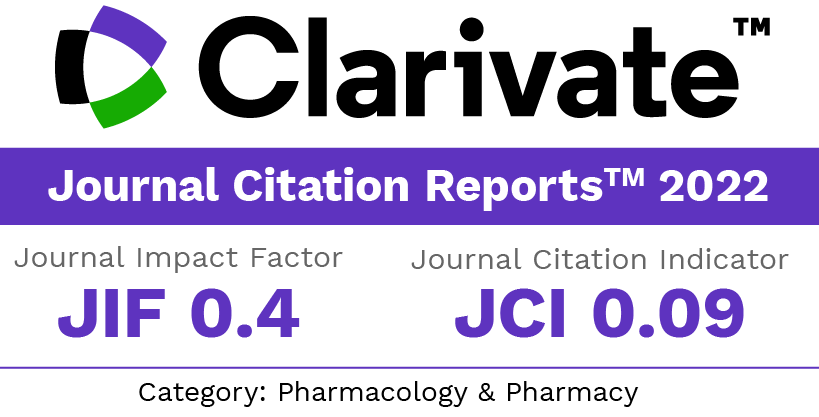Estudio de estabilidad de suspensiones farmacéuticas de liberación modificada de clorhidrato de morfina
Palabras clave:
Liberación modificada, Suspensiones farmacéuticas, Clorhidrato de morfinaResumen
El dolor crónico constituye un tema central en las ciencias de la salud contemporáneas con unos costes económicos yen términos de sufrimiento humano altamente elevados. Los opiáceos son una indicación clara para su tratamiento,donde la morfi na es el fármaco prototipo y el más representativo. Por otra parte, la vía oral es la vía de elección porser la más cómoda y la de mayor aceptación para el paciente. Actualmente, los sistemas de liberación controlada sepresentan como los más apropiados en el tratamiento del dolor crónico, estando su diseño y elaboración asociadosal empleo de polímeros como vehículos transportadores del fármaco. Por tanto, la fi nalidad del presente estudiofue la preparación de una suspensión coloidal para uso oral, siendo el vehículo transportador del principio activoun pseudolátex de etilcelulosa, de manera que la morfi na quedara microencapsulada por las partículas poliméricas,obteniéndose así una forma líquida de liberación controlada, apta para personas con difi cultad en la digestión o deglucióncomo niños o ancianos. Además se llegó al diseñó de una fórmula fi nal estable gracias al estudio de diversosviscosizantes de distinta naturaleza y a diferentes concentraciones (goma xantán, carbopol y carboximetilcelulosasódica y avicel). Se realizaron ensayos de sedimentación y un exhaustivo estudio del comportamiento reológico paraasegurar la obtención de una suspensión que no sedimentara fácilmente y se reconstruyera con facilidad medianteligera agitación, además de presentar un adecuado fl ujo natural desde el envase.Descargas
Citas
Casals M. and Samper D. Effectiveness, tolerability and quality of life in the management of chronic pain unrelated to cancer with sustained-release tramadol administered in a single daily dose. Rev. Soc. Esp. Dolor 2004; 11: 129-140.
Franco ML. and Seoane de Lucas A. Characteristics of chronic pain among the elderly: management. Rev. Soc. Esp. Dolor 2001; 8: 29-38.
Vidal MA, Calderón E, Martínez E, Gonzálvez A, Torres LM. Pain in neonates. Rev. Soc. Esp. Dolor 2005; 12: 98-111.
Couvreur P. Polyalkylcyanocrylates as colloidal drug carrier. CRR CritRev TherDrugCarrierSyst. 1988; 5: 1-20.
Gurny R, Peppas NA, Harrington PD and Banker GS. Development of biodegradable and injectable lattices for controlled release of patent drug. Drug Dev. Ind. Pharm 1991; 7: 1.
Morales ME, Gallardo Lara V, Calpena AC, Doménech J and Ruiz MA. Comparative study of morphine difusión from sustained release polymeric suspensions. J. Control. Release 2004; 95: 75-81.
Speiser P. and Rirrenbach. Microcapsules in the nanometric range and a method for their production. US Patent No 4021364, 1997.
Ruiz MA, Reyes I, Parera A and Gallardo V. Adsorption of omeprazole on latex particles and characterization of the
complex. Il Fármaco 2000; 55: 314-318.
Gallardo V, Zouaki Y, Parera A. and Ruiz MA. Employment of a cellulosis polymer as carrier of diethylamine salicylate in topical formulations. Reactive & Polymers 2000; 43: 351-357.
Schwope AD,Wise DL. and Howes JF. Development of polylactic/glycolic acid delivery systems for use in treatment of narcotic addiction. Natl. Inst. Drug Abuse Res 1976. Monogr. Ser. 4, 13.
Lamas MC, Frías M, Valázquez R. and Bregni C. Microspheres obtained by múltiple emulsions. Boll. Chim. Farma 1998; 9: 357-361.
Freiberg S. and Zhu XX. Polymer microspheres for controlled drug release. Int. J. Pharm 2004; 282: 1-18.
Vanderhoff JW, El-Aaser MS. and Ugelstad J. Patent 4, 177,177,1979.
Llacer JM, Ruiz MA, Parera A. and Gallardo V. Adsoption-desorption of ondansetron of latex particles. Drug Dev. Ind. Pharm 2000; 26: 237-242.
Matthews BA and Rhodes CT. Use of the Derjaguin, Landau, Verwey and Overbeek theory to interpret pharmaceutical
suspension stability. J.Pharm. Sci. 1970; 59: 521.
Tuncçel T. and Gürek F. Eur. J. Pharm. Biopharm 1992;38:82.
Sellés E. Suspensiones. In Sellés, E. Farmacia Galénica General 1995. Madrid.
Rigamonti S. and Rugginenti G. Pharmaceutical suspensions. Il Farmaco 1969; 24: 445.
Puisieux F and Frances, J. Prod. et Prob. Pharm 1973; 28: 360.
Delgado AV, Gallardo V, Parera A and González Gaballero FA. Study of the electrokinetic and stability properties of nitrofurantion suspensions. II flocculation and redispersion properties as compared with theoretical interaction energy curves. J. Pharm. Sci. 2000; 79: 709-715.
Bueno JL. Empleo de polielectrolitos para la floculación de suspensiones de partículas de carbón. Fundación Juan March 1979; 95:16.
Rudraraju VS and Wyandt C. Rheological characterization of Microcrystalline cellulose/sodiumcarboxymethyl cellulose hydrogels usina a controlled stress rheometer. Part I and II. International Journal of Pharmaceutics 2005; 292: 53-61.
Vasiljevic D, Parojcic J, Primorac M and Vuleta G. An investigation into the characteristics and drug release properties of multiple w/o/w emulsion systems containing low concentration of lipophilic polymeric emulsifier. Int J Pharm 2006;309:171-177.
Nakamura H and Tachi K. Dynamics of shear-thinning suspensions of core-shell structured latex particles. J. Colloid Interface Sci. In press.
Descargas
Publicado
Cómo citar
Número
Sección
Licencia
Los artículos que se publican en esta revista están sujetos a los siguientes términos en relación a los derechos patrimoniales o de explotación:
- Los autores/as conservarán sus derechos de autor y garantizarán a la revista el derecho de primera publicación de su obra, la cual se distribuirá con una licencia Creative Commons BY-NC-SA 4.0 que permite a terceros reutilizar la obra siempre que se indique su autor, se cite la fuente original y no se haga un uso comercial de la misma.
- Los autores/as podrán adoptar otros acuerdos de licencia no exclusiva de distribución de la versión de la obra publicada (p. ej.: depositarla en un archivo telemático institucional o publicarla en un volumen monográfico) siempre que se indique la fuente original de su publicación.
- Se permite y recomienda a los autores/as difundir su obra a través de Internet (p. ej.: en repositorios institucionales o en su página web) antes y durante el proceso de envío, lo cual puede producir intercambios interesantes y aumentar las citas de la obra publicada. (Véase El efecto del acceso abierto).



















